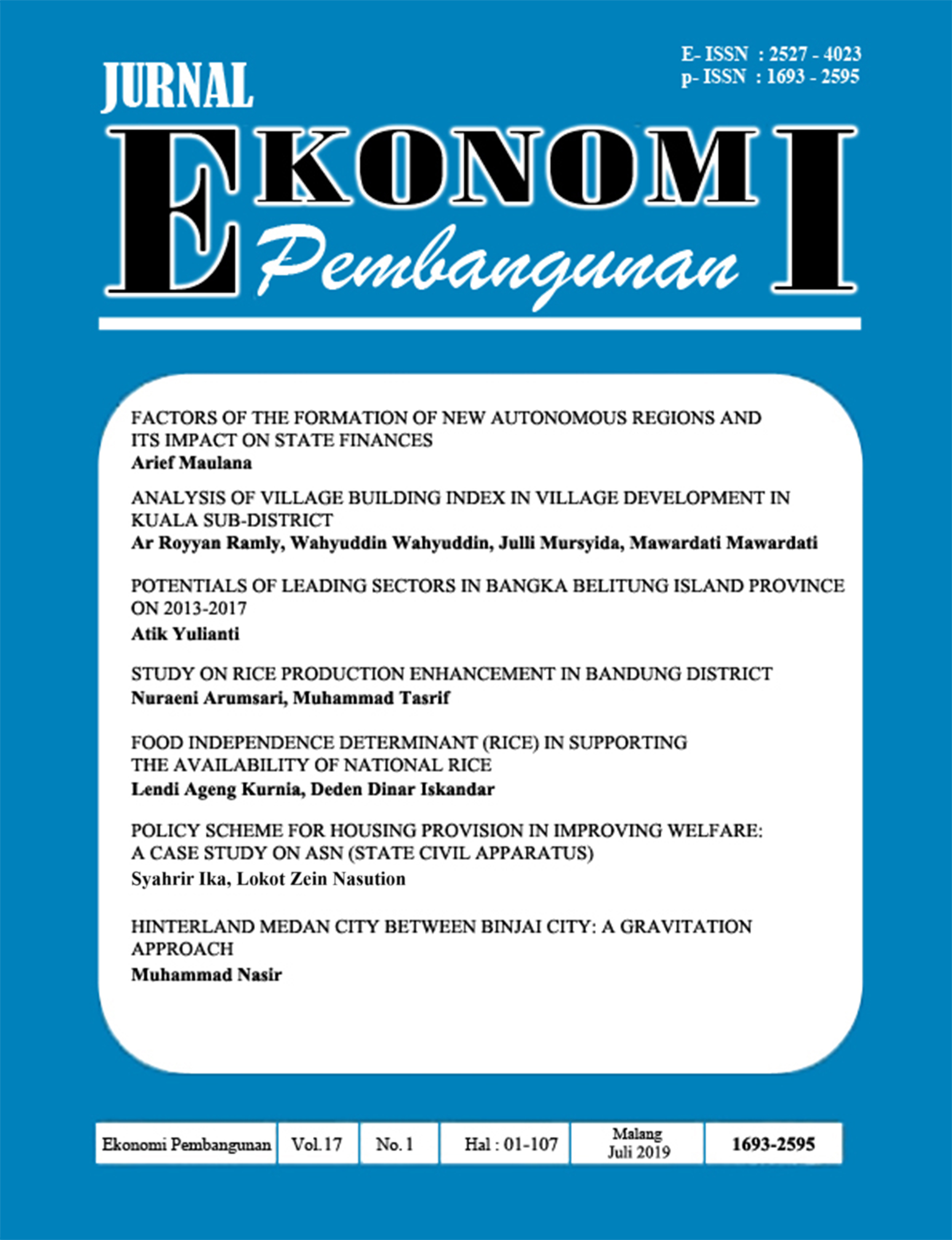Factors Of The Formation Of New Autonomous Regions And Its Impact On State Finances
DOI:
https://doi.org/10.22219/jep.v17i1.8685Keywords:
New Autonomous Region, Government Policy, State FinanceAbstract
The purpose of this study is to analyze the driving factors of the formation of new autonomous regions in Indonesia during the reformation era and its impact on state finance. This study is a policy study by collecting data and then analyzing it into a conclusion and recommendation. This type of study is a literature study with the method used is descriptive qualitative method. The results of the study show that since the reform era, the formation of a new autonomous region has been very massive. If calculated on average from 1999 to 2014, each year the new regions increase by 13 regions per year. The formation of the new autonomous regions requires considerable preparation and costs, starting from the initial formation to the implementation. In addition, in general the new autonomous regions show higher fiscal dependencies than the old regions. Thus, it can be stated that the establishment of the new autonomous regions has caused pressure on the state finances due to the large amount of funds that must be transferred to new regions.
Downloads
References
Anwar, K. (2014). Analisis Dampak Defisit Anggaran terhadap Ekonomi Makro di Indonesia. Jejaring Administrasi Publik, 2.
Bappenas. (2008). Studi Evaluasi (Impact) Penataan Daerah Otonom Baru. Jakarta.
BPP Kemendagri. (2013). Himpunan Hasil Kelitbangan. Jakarta.
Budiardjo, M. (2013). Dasar-Dasar Ilmu Politik. Jakarta: Gramedia.
Creswell, J. D. (2016). Research Design: Pendekatan Metode Kualitatif, Kuantitatif, dan Campuran (4th ed.). Yogyakarta: Pustaka Pelajar.
Harefa, M. (2017). Optimalisasi Kebijakan Penerimaan Daerah. Jakarta: Pustkaa Obor Indonesia.
Haryanto, J. T. (2017). Desentralisasi Fiskal Seutuhnya. Retrieved November 25, 2018, from https://www.kemenkeu.go.id/publikasi/artikel-dan-opini/desentralisasi-fiskal-seutuhnya/%0A
Huda, N. (2015). Hukum Pemerintahan Desa. Hukum Pemerintahan Desa. Bandung: Nusa Media.
Kaho, J. R. (2002). Prospek Otonomi Daerah di Negara RI. Jakarta: PT Rajawali Grafindo Persada.
Khusaini, M. (2006). Ekonomi Publik: Desentralisasi Fiskal dan Pembangunan Daerah. Malang: BPFE Unibraw.
Litvack, J., Ahmad, J., & Bird, R. (1999). Fiscal Decentralization in Developing Countries. In Sector Studies Series (p. 48). Washington, DC: The World Bank. https://doi.org/10.1017/CBO9780511559815
Mardiasmo. (2009). Otonomi dan Manajemen Keuangan Daerah. Yogyakarta: Andi Press.
Nadir, S. (2013). Otonomi Daerah dan Desentralisasi Desa: Menuju Pemberdayaan Masyarakat Desa. Jurnal Politik Profetik, 1(1).
Prasojo, E. (2011). Jorjoran Pemekaran Daerah: Instrumen Kepentingan Ekonomi Politik. Spirit Publik, 1(7).
Pratikno. (2011). Usulan Perubahan Kebijakan Penataan Daerah (Pemekaran dan Penggabungan Daerah). Spirit Publik, 1(7).
Sarundajang, S. H. (2002). Arus Balik Kekuasaan Dari Pusat ke Daerah. Jakarta: Pustaka Sinar Harapan.
Siswanto, S. (2012). Hukum Pemerintahan Daerah Di Indonesia. Jakarta: Sinar Grafika.
Soehino. (1999). Ilmu Negara. Yogyakarta: Liberty.
Wijaya, A. (2017). Bahaya Anggaran Negara: Pajak Seret, Proyek Infrastruktur Membebani. Retrieved November 25, 2018, from https://katadata.co.id/telaah/2017/10/14/bahaya-anggaran-negara-pajak-seret-proyek-infrastruktur-membebani
Republik Indonesia, Undang-Undang Republik Indonesia Nomor 22 Tahun 1999 tentang Pemerintah Daerah.
Republik Indonesia, Undang-Undang Republik Indonesia Nomor 17 Tahun 2003 tentang Keuangan Negara.
Republik Indonesia, Undang-Undang Republik Indonesia Nomor 32 Tahun 2004 tentang Pemerintah Daerah.
Republik Indonesia, Undang-Undang Republik Indonesia Nomor 23 Tahun 2014 tentang Pemerintah Daerah.
Republik Indonesia, Undang-Undang Republik Indonesia Nomor 09 Tahun 2015 tentang Pemerintah Daerah.
Republik Indonesia, Peraturan Pemerintah Republik Indonesia Nomor 78 Tahun 2007 Tentang Tata Cara Pembentukan, Penghapusan dan Penggabungan Daerah.Downloads
Published
Issue
Section
License
Authors who publish with Jurnal Ekonomi Pembangunan (JEP) agree to the following terms:
- For all articles published in Jurnal Ekonomi Pembangunan (JEP), copyright is retained by the authors. Authors permit the publisher to announce the work with conditions. When the manuscript is accepted for publication, the authors agree to the publishing right's automatic transfer to the publisher.
- Authors retain copyright and grant the journal right of first publication with the work simultaneously licensed under a Creative Commons Attribution-NonCommercial-ShareAlike 4.0 International License that allows others to share the work with an acknowledgment of the work's authorship and initial publication in this journal.
- Authors can enter into separate, additional contractual arrangements for the non-exclusive distribution of the journal's published version of the work (e.g., post it to an institutional repository or publish it in a book), with an acknowledgment of its initial publication in this journal.
- Authors are permitted and encouraged to post their work online (e.g., in institutional repositories or on their website) before and during the submission process, as it can lead to productive exchanges and earlier and greater citation of published work (See The Effect of Open Access).

This work is licensed under a Creative Commons Attribution-NonCommercial-ShareAlike 4.0 International License.






















